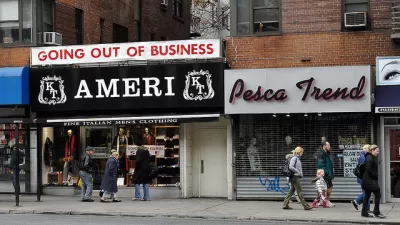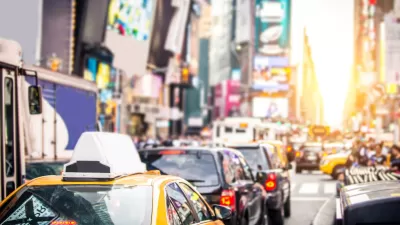Why are so many shops closing in New York's richest and best-known neighborhoods?

Tim Wu reports on a counter-intuitive "surge of closings and shuttered shops" in New York's West Village and other affluent neighborhoods with unparalleled demand.
"Abandoned storefronts have long been a hallmark of economic depression and high crime rates, but the West Village doesn’t have either of those. Instead, what it has are extremely high commercial rents, which cause an effect that is not dissimilar. 'High-rent blight' happens when rising property values, usually understood as a sign of prosperity, start to inflict damage on the city economics that Jane Jacobs wrote about."
Wu goes on to list some of the closings that have occurred in the neighborhood—and the rising rents that preceded the loss of the businesses. As for why the vacant units don't immediately get filled by new tenants, Wu speculates that it could be tax benefits, but it could also be a form speculation:
"[Landlords will] trade a short-term loss for the chance eventually to land a much richer tenant, like a bank branch or national retail chain, which might pay a different magnitude of rent. If you’re a landlord, why would you keep renting to a local café or restaurant at five thousand or ten thousand dollars a month when you might get twenty thousand or even forty thousand dollars a month from Chase?"
Wu allows that leaving the blight of vacant retail properties threatens to destroy what makes such neighborhoods so desirable in the first place.
As for what can be done to imitigate the problem, Wu mentions two regulatory proposals with support from local advocates. One would "limit rent spikes by making commercial-lease-renewal disputes subject to mandatory mediation and arbitration, like some baseball salaries." The other would fine landlords for leaving storefronts empty. Wu also mentions the possibility of allowing interim uses in the storefronts.
FULL STORY: Why Are There So Many Shuttered Storefronts in the West Village?

Alabama: Trump Terminates Settlements for Black Communities Harmed By Raw Sewage
Trump deemed the landmark civil rights agreement “illegal DEI and environmental justice policy.”

Planetizen Federal Action Tracker
A weekly monitor of how Trump’s orders and actions are impacting planners and planning in America.

The 120 Year Old Tiny Home Villages That Sheltered San Francisco’s Earthquake Refugees
More than a century ago, San Francisco mobilized to house thousands of residents displaced by the 1906 earthquake. Could their strategy offer a model for the present?

San Francisco Opens Park on Former Great Highway
The Sunset Dunes park’s grand opening attracted both fans and detractors.

Oregon Legislature to Consider Transit Funding Laws
One proposal would increase the state’s payroll tax by .08% to fund transit agencies and expand service.

Housing Vouchers as a Key Piece of Houston’s Housing Strategy
The Houston Housing Authority supports 19,000 households through the housing voucher program.
Urban Design for Planners 1: Software Tools
This six-course series explores essential urban design concepts using open source software and equips planners with the tools they need to participate fully in the urban design process.
Planning for Universal Design
Learn the tools for implementing Universal Design in planning regulations.
Clanton & Associates, Inc.
Jessamine County Fiscal Court
Institute for Housing and Urban Development Studies (IHS)
City of Grandview
Harvard GSD Executive Education
Toledo-Lucas County Plan Commissions
Salt Lake City
NYU Wagner Graduate School of Public Service





























